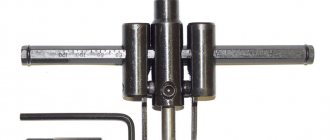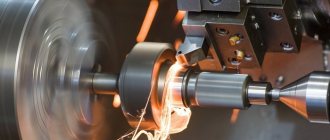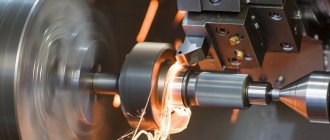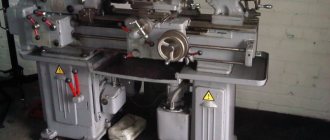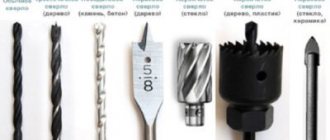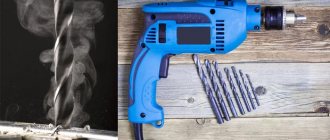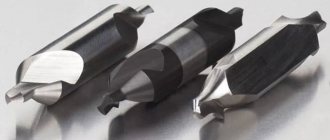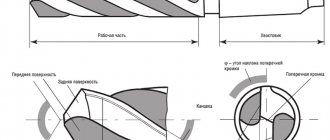When laying communications, installing lighting fixtures or installing household appliances, it is almost always necessary to drill round holes of large diameters in walls, ceilings or interior items. A comfortable ballerina drill will be a good helper in your work.
You can drill a small diameter hole (10-12 mm) in the surface using a simple electric drill. But even when trying to cut large diameter holes in the working surface, even a metal drill begins to vibrate and deviate from the vertical axis.
Specifications
To obtain a high-quality hole of the required size in such cases, you will need a special tool - a ballerina (round drill).
| Tool Options | Parameter values |
| Tool weight | 0.1-0.110 kg |
| Length | 90-120 mm |
| Shank type | Cylindrical |
| Shank length | 8-9 mm |
| Maximum outer circle diameter | 140-160 mm |
| Minimum outer circle diameter | 20-30 mm |
| Diameter of support bar | 7 mm |
| Working surface processing depth | 30 mm |
| Number of working cycles (for ballerina on tiles) | 30-40 |
Characteristics of metal for drill
The ballerina is made of high-quality carbon (tool) steel, which does not contain alloying additives or impurities. Carbon steel is used for the manufacture of high-strength static cutting tools that experience significant mechanical and physical stress.
The properties of carbon steel provide the ballerina with the following characteristics:
| Characteristic | Content |
| Hardness | Ensures that the drill remains in a vertical position when working with it |
| Strength | Ensures uninterrupted operation of the ballerina when drilling deep layers of the working surface |
| Cyclic strength | Maintains performance characteristics after repeated use |
| Plastic | Possibility of adjusting cutters |
| Heat resistance | Possibility of maintaining the working qualities of the tool when drilling at high speeds and heating |
| Wear resistance | Long tool life and resistance to corrosion processes |
Characteristics of a metal drill
The ballerina allows craftsmen to work with metal surfaces (steel, cast iron, brass, aluminum, bronze) up to 14 mm thick. Using this type of drill, mounted in a drill or in a tabletop drilling machine, you can cut a hole with a radius of 22-105 mm in a metal surface.
Types of instruments
In addition to the classic two-cutting version of a circular drill, there are one- and three-cutting models. In the design of a single-cut drill, the cutting part is directly fixed to the rod. The cutter and centering lance are equipped with carbide plates. They make it easier for a ballerina to work on tiles.
Read also: How to tighten a belt with two rings
In three-incisor models, the incisors are mounted on a round platform on which there are grooves. The cutters move along these grooves. They have a scale. Correctly set size allows you to cut more accurately and quickly.
Currently, some models are equipped with a protective grille made of plastic. It improves work efficiency and convenience.
The ballerina for metal is equipped with plates made of hard alloy with sharpening of a cutting turning tool. High cutting force dictates the use of stationary or portable radial drilling machines. Basically, holes are cut in galvanized sheets, the thickness of which does not exceed one millimeter.
Adjustable tool overview
Ballerina – adjustable drill. One of its structural elements is a bracket with a scale printed on it. With its help, you can independently set the required diameter. And in a three-cut drill, the cutting elements move synchronously along special grooves.
Before starting work (drilling), it is necessary to set both cutters at the same distance from the central hole.
Ballerina design
- Centering drill.
- Working incisors (from one to three)
The main drill can be firmly fixed on the work surface (drilled) and prevent the tool from slipping when working with tiles or laminated surfaces. The cutters move in a circle and cut a groove in the working surface. The drill is driven using power tools (drill, machine, hammer drill) or manually (using a brace).
A tool with replaceable cutters is used to work with surfaces of varying strengths - from soft plastic to porcelain stoneware. The master can independently set the working cutters to obtain a hole of a given diameter. This operation can be performed using an adjustable wood ballerina.
Features of the device
The design of the device is simple, reliable and high-performance.
A circular drill, or ballerina drill for cutting gaskets, consists of a central drill with a groove, a round or triangular shank, two carriages and cutters located on the arms of the bracket. The purpose of the drill is to mark the center for the hole and provide support for the device during rotation. There are special markings on the bracket rod for installing the sliding carriage in the desired position. The cutters are fixed with screws, and the spread of the working edges is checked with a caliper.
A distinctive feature of a ballerina with one knife is the asymmetrical design and a noticeable lever that counteracts rotation, creating a high range of oscillation of the instrument. For this reason, experts recommend using the device on a stationary drilling machine. This will help prevent the work material from falling off and protect the worker.
The best option when working with a drill, screwdriver, hammer drill or rotary hammer is a system of two cutters that compensate each other in terms of balance during rotation. The disadvantage of the design is the rapid heating of the cutting part; the drill must cool down several times during the task. To maintain the functionality of the tool, it is recommended to maintain an operating mode ranging from 1000 to 1400 rpm.
Types of ballerinas
To work with materials of different densities and structures - soft and hard wood, plastic, plasterboard, concrete, stone, brick, porcelain stoneware - drills made from various grades of steel and having special designs are used.
For woodworking
You can drill a large diameter hole in a wooden surface using a 200 mm wood ballerina.
Before you start drilling in a wooden surface (especially laminated or veneered), you need to make a shallow hole with an awl. This will allow you to accurately comply with the specified dimensions. Drill at low or medium speeds (1000-1200 rpm) to avoid chipping at the exit (if necessary, drill a through hole).
To work with hard wood, use wood ballerina 40 (300). In some cases (hardwoods) a wood ballerina with a diameter of 30 200 mm mk is used (category Strong -stk, 057)
Drilling drywall
The design of the ballerina on plasterboard includes a centering tip and a rod attached above. The rod mount can rotate around its own axis.
At one end of the rod there is a disk cutter. It easily withstands several drilling cycles, holds tightly to the rod during operation and does not require sharpening for a long time.
For tiles
To drill hard tiles, a tile ballerina is used. The main difficulty in performing this operation is the need to cut through the glazed coating.
Immediately after this, experienced craftsmen advise drilling a groove on the back side of the tile. And then complete the drilling from the front side. For ballerinas on tiles 300 (057), a pobedit tip is often used, with which you can cut neat holes.
It is recommended to start working with a ballerina drill on tiles at low speeds (about 1000 rpm). And lubricate the drawn contour of the future hole with machine oil.
For porcelain stoneware
Porcelain stoneware is a very hard material. Working with him is always a difficult task. If it is necessary to cut a hole in porcelain stoneware, a ballerina with special cutting edges and a diamond tip is used. Its use extends the service life of the tool and significantly increases the speed of the operation.
On ceramics
When using a ballerina when working with ceramics, you should apply minimal physical effort. Ceramics is a fragile material. And even slight vibration can lead to cracks and chips. To avoid this, drilling should be carried out at low speeds (about 1000 rpm). Typically, diamond-coated tips are used for work.
For metal
A metal-cutting tool that makes it possible to obtain a hole with a diameter of 40-150 mm in sheet iron is a metal drill. Before starting the operation, a depression (up to 9 mm) is made in the center of the required cutout. It will be possible to install and securely fix the central axis of the ballerina.
For cutting gaskets
Car enthusiasts often encounter wear on the oil pump and overdrive gaskets. Of course, you can order and buy a new one in auto supply stores and online stores. But even in a home workshop, with the help of a ballerina, you can cut out a gasket from paronite. You need to have a sheet of paronite 0.5 mm thick, a measuring tool (ruler, tape), glue, several blades for stationery knives and a marker for marking. Place the worn gasket on the paronite sheet, glue it (without drying the glue) and trace along the contour.
To cut out the gasket along the outer and inner contours, a wood ballerina is used. Internal holes and grooves are cut with blades and finished with a round file or sandpaper.
For plastic
Plastic is a soft material and can be easily processed. But there is always a danger of cracking of the working surface. Therefore, when drilling plastic, you should not use much physical effort.
This material is quickly exposed to high temperatures and melts. It is necessary to work with it at low drill speeds (about 1000 rpm).
Compass ballerina
This type of drill is used for working with tiled surfaces. The design of the instrument includes:
- The pen tip acts as the main axis.
- Movable part (fastening mechanism, extension lever, cutting edge).
The cutting edge should be 5-8 mm shorter than the pen tip. This is due to the difficulty of processing tiles (there is a danger of the drill slipping).
You can use masking tape (adhesive tape) to firmly hold the markings. It also improves the adhesion of the drill to the surface, allowing it to be fixed on the drilling axis and make a central recess.
Due to the difficulties with sharpening a cutter made of hard alloys at home, a compass is considered a disposable tool. However, you can find sales of drills with replaceable bits.
Types by number of incisors
On sale you can find three types of drills, differing in the number of working cutters. A special bracket with a perpendicular tightening screw has a single-cut drill. Before starting the operation, the working cutter is simply set to a given length and tightened with a screw.
But in a double-cut ballerina, the bolts for fastening are located on the holders of the working cutters. The master sets them at the same distance from the central axis before starting work. The most complex design is a circular tile drill with three cutters. They are fixed on a circular platform and are aligned when moving along the grooves provided for this purpose.
Characteristics of a wood drill
When working with hard wood, fiberboard, chipboard, plasterboard and plywood, drills are selected individually, taking into account the thickness of the material, which should not exceed 1.5 cm. A do-it-yourself wood ballerina is assembled from a set of drills and replacement parts included in the equipment set . The structure can be rotated with a rotary hammer, drill or drilling machine at low or medium speeds.
The work process is divided into several stages:
- Drilling with a central twist drill,
- Cutting paths around the circumference,
- Removing a cut element.
The main condition for working with loose wood is the choice of tools for drywall. When making blind or through holes, fixtures made of carbon and alloy steel are used.
There are two ways to drill a quality hole with smooth edges:
- By drilling a small diameter grommet from both sides to the middle of the board
- By drilling through a wooden spacer.
Working on material with a laminated or veneer surface requires preliminary marking of the drilling location with a core or an awl.
Device capabilities
The device for working with wood has a long service life, lends itself well to sharpening knives at the desired angle, and makes it possible to create a gap with a radius of 2.0 to 15.0 cm. For safety reasons, the master is recommended to use a tool equipped with a protective grill screen.
Making a ballerina cutter
A ballerina drill significantly saves time when processing (milling) the contours of a cut hole. Processing is carried out automatically using power tools (drill, hammer drill).
Therefore, the physical effort expended when working with a ballerina is also insignificant. Given these advantages, home craftsmen want to have such a tool in their workshop. Moreover, making a ballerina with your own hands is not at all difficult for a competent craftsman.
For this you will need materials:
- Working (metal) plate with dimensions 200x25x4-6 mm.
- Bolts: M8 grade - 2 pieces (in addition to them you need to take 2 nuts and 4 washers) and M10 grade - 1 piece (in addition to them you need to take 2 nuts and 1 washer).
To work you will need tools:
- To mark the work surface: a marker and a ruler with centimeter divisions.
- Painting tape.
- Stationary machine or power tools (hammer, drill).
- Vise.
- File.
- Kern.
- Grinder equipped with grinding and cutting discs.
- Drills for metal with a diameter from 9 mm to 10.5 mm.
- Keys: open-end and adjustable.
- Screw clamps.
Step-by-step instructions on how to make it yourself
- Marking and processing of the work plate.
- Creation and processing of working grooves.
- Manufacturing of cutters.
- Connection of cutters to the working plate.
- Marking (gradation) of the finished drill.
- At the first stage, we cut a 20 cm long strip from the metal sheet. This will be the basis of the tool being created.
- Using a drill with a diameter of 10.5 mm, we drill a through hole on the machine in the pre-punched center of the work plate.
- Stepping back 1 cm from the drilled hole to the edges of the working plate (at the same level as the central hole), we make marks (punch) on the plate for future drilling.
- The distance between the marks must exceed the diameter of the holes that will subsequently be drilled. This precaution will help preserve the drill.
- Using a grinder cutting disc, you need to create two oblong grooves by combining the existing holes. The working plate is in a vice during this operation.
- Using a file (square or flat), we process the resulting holes. The free movement of the incisors will depend on the thoroughness of this operation (we remove irregularities, hangnails, and tubercles).
- Pressing the work plate tightly against the table (we use clamps or a vice), we smooth out all the irregularities and sharp corners with a grinding disc. We insert an M10 bolt into the central hole and screw one of the nuts onto it from the reverse side.
- We put the second nut (lock nut) on it and press it tightly using an open-end (or adjustable) wrench. To make the cutters, we wrap the upper parts of the M8 bolts with masking tape. We fix the bolt heads in a vice.
- Using a grinder's grinding disc, we cut off the thread, processing the bolt on both sides until a metal handle 4-5 mm thick is formed.
- The pointed ends of the bolt, shaped like a one-sided hook, will serve as the working cutters of the drill. The resulting cutters must be inserted into the grooves, having previously been laid with washers on both sides.
- This will increase the area of their contact with the working plate.
- The rod of the future tool and the cutters should be located in opposite directions. The thread sections remaining on the side surfaces of the bolts will allow you to screw on the nuts and secure the cutters tightly.
- Using a ruler and a marker, we mark the entire plane of the working plate, making marks every 0.5 cm. Later on these marks it is necessary to make notches that will be clearly visible during operation.
Design and principle of operation
The design of a circular drill is quite simple and mainly consists of three parts:
- a drill responsible for centering the device;
- a fastening rod of a certain length on which the cutting elements are installed;
- cutters equipped with a device for attaching them to a rod, their number ranges from one to three.
This design is used on single and double cutter models. If there are three cutting elements, then in this case the cutters are fixed on a round disk, and to change the radius they move along the grooves. Additionally, some models can be equipped with a protective cover that protects the working person from flying chips or sawdust. It also protects the worker from being hit by fragments when the device is destroyed.
Now let's see how to drill. The central drill needs to be drilled at a pre-designated point. If the materials are durable, for example, iron, tiles or laminate, then it is better to first mark the drilling location with a regular drill. This is done for convenience so that the “ballerina” does not slip on the surface and scratch the top layer.
Next, we cut a path of the radius we need
Again, here you need to pay attention to the material in which the holes are drilled. If it is a tile, then to prevent damage to the facade surface you need to drill at low speed and lubricate the tile with water or machine oil
This will prevent damage to the tiles and the scattering of fragments. Tile panels must be laid on a flat surface, otherwise they will crack under force.
If the tile is already attached to the walls or floor, then you only need to cut through it, and then replace the “ballerina” with a concrete drill. When drilling laminate or veneer, it is difficult to go through the top layer, but then it goes easier. There are no special instructions for wood, iron, plastic and drywall. The last stage is removing the cut out objects.
In addition to the basic instructions, there are a few additional nuances.
- In no case should you put pressure on the tool or lean on it with your whole body: this can damage the device and split the material in which the hole is made;
- “impact” or “perforator” modes cannot be used, only drilling;
- there is no need to let the “ballerina” overheat: high temperatures can deteriorate the coating of the incisors;
- if drilling is difficult, then you should add speed.
To protect your health when working with a device for drilling circular holes, you need to follow simple rules:
- Before starting work, you need to check whether all components of the device are securely fastened;
- You should wear goggles or a mask to protect your eyes;
- clothing should not contribute to getting into the rotating elements;
- If possible, be sure to install a protective grille on the ballerina.
Advantages and disadvantages
Working with a ballerina is not particularly difficult for a home craftsman. However, even when using a three-cut drill, special skills are required.
| Advantages | Flaws |
| Saves time when you need to make a large diameter hole Exact compliance with specified dimensions Carefully processing the contour of the drilled hole Saving physical strength | Possibility of vibration when working with a single-tip drill Wear and destruction of cutters Clamp screw breakage The need to take breaks during work, which prevents overheating of the nozzle |
Main advantages
The advantages of using adjustable circular drills with cutters are obvious. They can make large diameter holes of different sizes in a limited space, not only on a flat surface, but also with imperfections. Manufacturers produce such tools for working with different materials. When choosing a specific model, you need to focus on the following factors and parameters:
- what material is the product intended for;
- number of cutting elements;
- cutter material;
- design features (presence of a scale, ability to replace wearing parts);
- manufacturer company.
The last factor affects the service life: cheap products cannot be of high quality. The best ballerina drills are products manufactured by Irwin (USA), TopFix (China), Stayer (Russia).
Ballerina drills under these brands are distinguished by their affordable price combined with quality. Such a tool is widely used in the workshops of manufacturing enterprises, on construction sites, in workshops for the production of furniture and souvenirs, as well as by home craftsmen.
Precautionary measures
- All parts of clothing (work apron, robe, shirt cuffs) must be secured (tied, buttoned).
- To prevent metal shavings and dust from getting into your eyes, you must wear work glasses.
- It is advisable to tuck long hair under a cap (beret, bandana).
- Rotating parts of drills and power tools (machine) must be securely fastened.
- It is advisable to use a ballerina equipped with a protective grille.
The working surface should be less hard than the steel from which the drill is made. Bring the already rotating drill to the surface. These tips will help extend the life of your tool.
How to choose the right one
When purchasing a drill, be sure to evaluate the configuration of the ballerina. Three-cut drills are considered the most reliable and in demand.
They have good mounting screws that firmly secure the working cutters. The length of the working cutters should be 4-5 mm less than the length of the centering cutter.
Some models use standard clamps to secure the incisors. They require a Phillips screwdriver and are much less reliable than models with hex screws.
- For drilling tiles, it is better to choose a ballerina with two incisors. With its help, you can make a hole with a diameter of up to 160 mm, whereas when working with a single-cut tool, the maximum diameter will be only 120 mm.
- A double-sided wood ballerina will allow you to make a hole with a diameter of up to 300 mm. And for working with thin (less than 5 mm) sheets of wood, a special drill is included in the kit.
- To work with hard surfaces (metal, porcelain stoneware, stone), use a one-sided ballerina. Before drilling begins, its central axis is securely clamped in the drill chuck.
On the brackets of branded ballerina models there is a ruler with clearly visible divisions. As a rule, the movement of the cutters is carried out synchronously. You should also pay attention to the width of the incisor run (it can be up to 150 mm). This parameter determines the radius of the future hole. Usually, the quality of the working surface (wood, metal, tile) is taken into account when choosing the permissible width of the cutters.
Some models are equipped with a protective plastic grid that holds large sawdust.
Characteristics of a metal drill
A special purpose tool is used to drill a hole in metal. The most popular device is considered to be a one-sided ballerina drill for metal, with a cylindrical axis and cutters with a cutting edge made of pobedite. Before drilling, a hole with a diameter of 0.9 cm is created in the metal for the hook of the tip of the central axis of the circular drill. The device allows you to make a through or blind cavity with a diameter of 40 mm to 150 mm.
For large hole diameters on MDF, plastic, multi-layer plywood, special tools with cutting knives are used to create cavities with a radius of 300 mm. Similar in design, but with excellent characteristics, devices cut ceramic and tiles. Each device model is provided with accompanying documents, which indicate the design features of the equipment and the maximum thickness of the material being processed.
A ballerina for cutting gaskets can most often look like a shank with a flattened cutting part and a screw tip. The feather drill has a high working potential and is produced from alloy steel in different dimensional parameters, allowing you to drill plastic of any thickness.
Other tools used for the same purposes
Craftsmen can use several more tools to produce large-diameter holes. When drilling wooden surfaces (the diameter of the required hole exceeds 25 mm), you can use a Faustner drill.
Unlike a ballerina, it has a number of disadvantages:
- A large contact area with the working surface is accompanied by strong heating of the drill.
- It is difficult to align the central tip with the applied markings, because only the outer circle with the working incisors is visible.
- The Fostner drill bit is primarily intended for drilling blind holes (to hide the head of a nail if necessary).
- High price (due to the high heat resistance of the drill).
A hole saw is useful for drilling large diameter holes in hardwood, drywall, brick, and laminated surfaces. Some models of this tool are adjustable; you can set the required diameter yourself. When drilling hard surfaces (stone, porcelain tiles, concrete, tiles), you can use crowns. However, they are already produced with a given diameter. And the master has to buy several pieces of crowns or even a whole set. Such financial costs are not always justified. In addition, when working with crowns, a lot of fragments and construction dust are formed. Therefore, drilling using crowns in an already finished and furnished room is impossible.
How to drill a large hole in tiles
The need to drill large-diameter holes in tiles arises when preparing a place for installing pipes and other plumbing communications, as well as for installing electrical sockets. To drill such holes in tiles, special tools are used, which can be a tubular drill, a ballerina drill for tiles, etc.
The ballerina, with which you can create holes of various diameters in tiles, is somewhat reminiscent in its design of an adjustable drill bit used for working with wood products. The ballerina works on the principle of a compass: the central drill serves to center it, and the working cutter, which can move along a special bracket, cuts a hole of the required diameter on the surface of the tile. By adjusting the position of the cutter, it is possible to obtain holes whose diameter is in the range of 30–90 mm.
Drilling a hole with a ballerina
At the same time, the ballerina is unproductive, since you can only work with it at low drill speeds. Moreover, such a tool is not very convenient to use, since it is quite difficult to hold it in one position.
More effective (but also expensive) is a circular tile drill, which is often called a tubular drill. Its cutting part can be coated with diamond or tungsten carbide.
Drilling tiles with a tubular drill without a center begins at low speeds, slightly deflecting the drill from a vertical position
When using a tubular drill, you should adhere to a number of rules:
- perform drilling at a rotation speed not exceeding 500 rpm;
- intensively cool the tool during processing;
- use the tool only on a stationary drilling machine, if its design does not provide for it.
